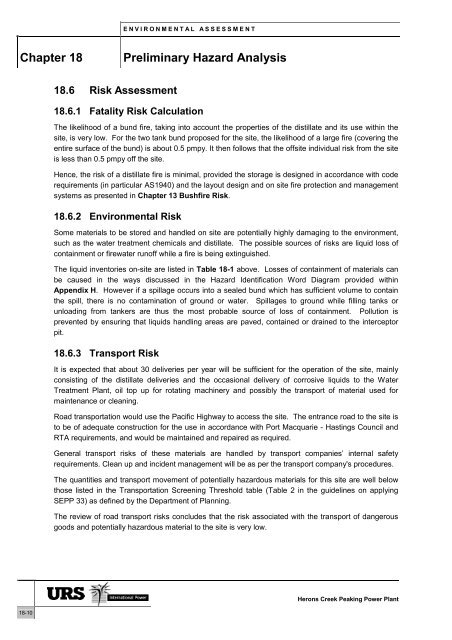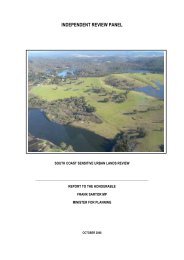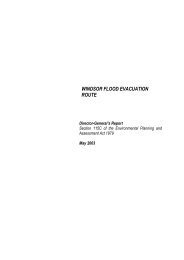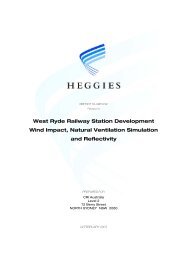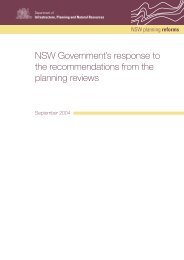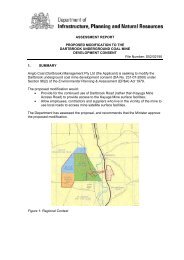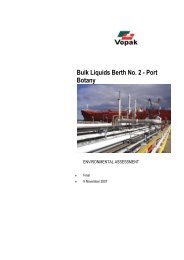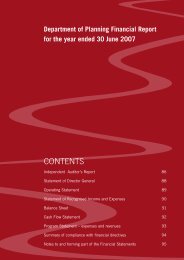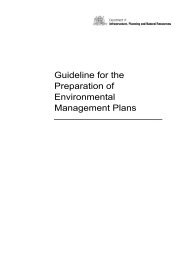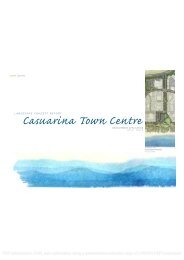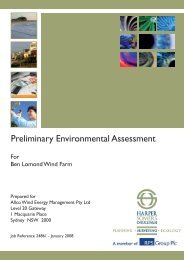Preliminary Hazard Analysis - Department of Planning
Preliminary Hazard Analysis - Department of Planning
Preliminary Hazard Analysis - Department of Planning
You also want an ePaper? Increase the reach of your titles
YUMPU automatically turns print PDFs into web optimized ePapers that Google loves.
E N V I R O N M E N T A L A S S E S S M E N T<br />
Chapter 18<br />
<strong>Preliminary</strong> <strong>Hazard</strong> <strong>Analysis</strong><br />
18.6 Risk Assessment<br />
18.6.1 Fatality Risk Calculation<br />
The likelihood <strong>of</strong> a bund fire, taking into account the properties <strong>of</strong> the distillate and its use within the<br />
site, is very low. For the two tank bund proposed for the site, the likelihood <strong>of</strong> a large fire (covering the<br />
entire surface <strong>of</strong> the bund) is about 0.5 pmpy. It then follows that the <strong>of</strong>fsite individual risk from the site<br />
is less than 0.5 pmpy <strong>of</strong>f the site.<br />
Hence, the risk <strong>of</strong> a distillate fire is minimal, provided the storage is designed in accordance with code<br />
requirements (in particular AS1940) and the layout design and on site fire protection and management<br />
systems as presented in Chapter 13 Bushfire Risk.<br />
18.6.2 Environmental Risk<br />
Some materials to be stored and handled on site are potentially highly damaging to the environment,<br />
such as the water treatment chemicals and distillate. The possible sources <strong>of</strong> risks are liquid loss <strong>of</strong><br />
containment or firewater run<strong>of</strong>f while a fire is being extinguished.<br />
The liquid inventories on-site are listed in Table 18-1 above. Losses <strong>of</strong> containment <strong>of</strong> materials can<br />
be caused in the ways discussed in the <strong>Hazard</strong> Identification Word Diagram provided within<br />
Appendix H. However if a spillage occurs into a sealed bund which has sufficient volume to contain<br />
the spill, there is no contamination <strong>of</strong> ground or water. Spillages to ground while filling tanks or<br />
unloading from tankers are thus the most probable source <strong>of</strong> loss <strong>of</strong> containment. Pollution is<br />
prevented by ensuring that liquids handling areas are paved, contained or drained to the interceptor<br />
pit.<br />
18.6.3 Transport Risk<br />
It is expected that about 30 deliveries per year will be sufficient for the operation <strong>of</strong> the site, mainly<br />
consisting <strong>of</strong> the distillate deliveries and the occasional delivery <strong>of</strong> corrosive liquids to the Water<br />
Treatment Plant, oil top up for rotating machinery and possibly the transport <strong>of</strong> material used for<br />
maintenance or cleaning.<br />
Road transportation would use the Pacific Highway to access the site. The entrance road to the site is<br />
to be <strong>of</strong> adequate construction for the use in accordance with Port Macquarie - Hastings Council and<br />
RTA requirements, and would be maintained and repaired as required.<br />
General transport risks <strong>of</strong> these materials are handled by transport companies’ internal safety<br />
requirements. Clean up and incident management will be as per the transport company's procedures.<br />
The quantities and transport movement <strong>of</strong> potentially hazardous materials for this site are well below<br />
those listed in the Transportation Screening Threshold table (Table 2 in the guidelines on applying<br />
SEPP 33) as defined by the <strong>Department</strong> <strong>of</strong> <strong>Planning</strong>.<br />
The review <strong>of</strong> road transport risks concludes that the risk associated with the transport <strong>of</strong> dangerous<br />
goods and potentially hazardous material to the site is very low.<br />
Herons Creek Peaking Power Plant<br />
18-10


